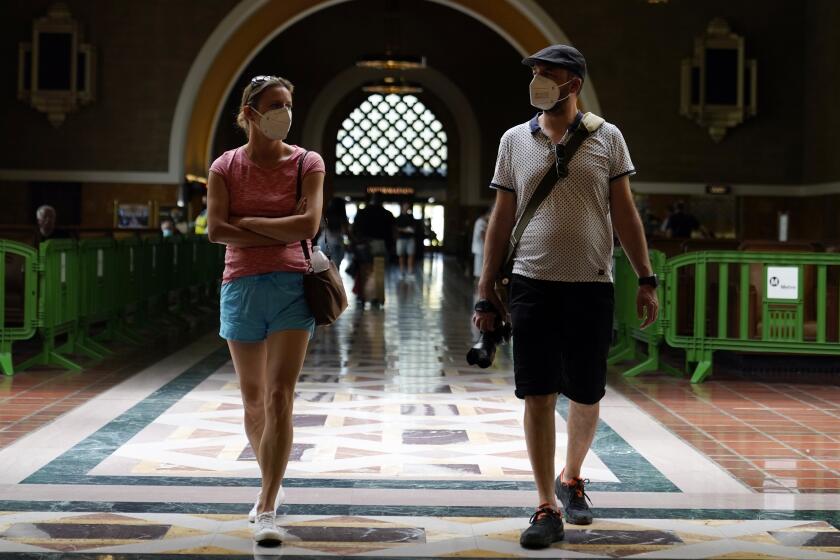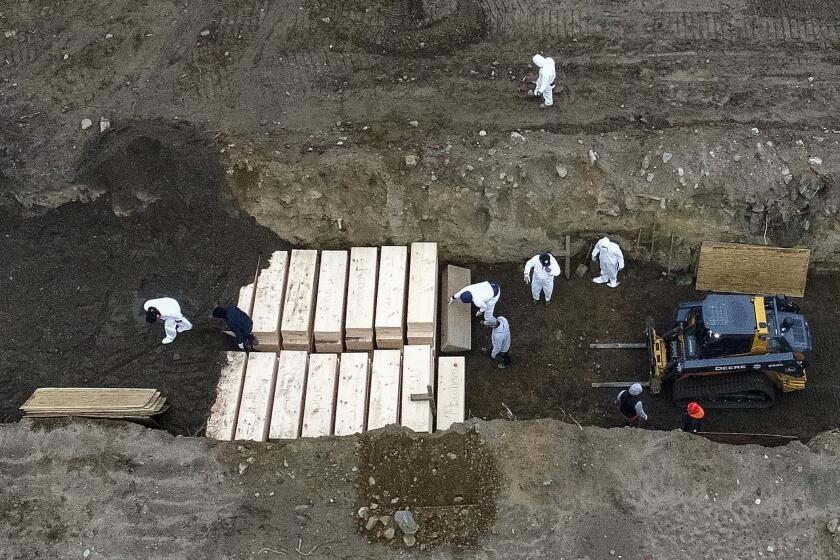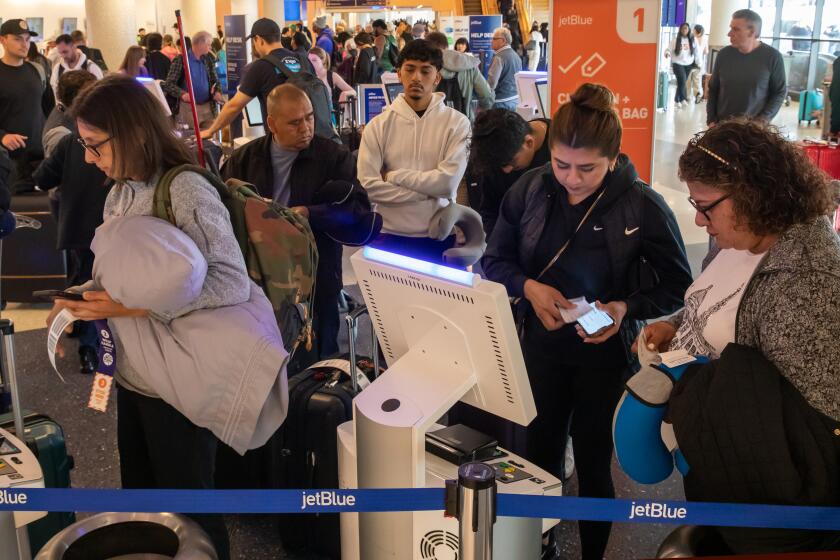New coronavirus subvariant Eris is gaining dominance. Is it fueling an increase in cases?

- Share via
A new coronavirus subvariant, nicknamed Eris, has rapidly risen to prominence nationwide and is now thought to account for more U.S. cases than any of its counterparts at a time when transmission has been creeping upward.
It’s possible the subvariant, formally known as EG.5, may have even further immune-escape advantage than some earlier members of the sprawling Omicron family — a viral dynasty that has dominated the globe since December 2021.
But officials emphasize that doesn’t necessarily mean Eris will cause a big wave.
“There are a couple of mutations on this particular variant that may have more immune evasion again. But it is very similar, and still a subset variant of Omicron,” California state epidemiologist Dr. Erica Pan said in a briefing with health professionals Tuesday.
Amid the latest coronavirus uptick in California, health officials reiterate the same advice: Masks work, but it’s a personal preference whether to wear them.
According to estimates from the U.S. Centers for Disease Control and Prevention, Eris comprised 17.3% of coronavirus specimens nationwide for the week ending Saturday, up from 11.9% a week earlier.
Eris is now estimated to be the most common distinctly identified subvariant nationwide. XBB.1.16, nicknamed Arcturus, has fallen to second place, and is estimated to comprise 15.6% of specimens. The third- and fourth-most common subvariants, respectively, are XBB.2.3, which some have nicknamed Acrux; and XBB.1.5, also known as Kraken.
In the Southwestern U.S. — California, Arizona, Nevada, Hawaii and the Pacific territories — the CDC estimates Arcturus is still the dominant subvariant, estimated to comprise 18.6% of viral specimens, with Eris second at 16.2%.
Unlike the pandemic’s earlier days, which were marked by distinctly different strains of the coronavirus struggling for dominance, more recent notable versions are all descendants of the Omicron variant. As a result, the World Health Organization hasn’t granted them official names beyond their alphanumeric identifiers — leading to an unofficial system, circulating on social media, using celestial or mythical monikers.
With the emergency phase of COVID-19 over, a Los Angeles Times analysis shows how the pandemic took different tolls on L.A. County and New York City.
Eris shares its name with one of the largest known dwarf planets in our solar system. Formerly known as Xena, it’s about the same size as Pluto, NASA says, and three times farther away from the sun. Eris is also the name of the Greek goddess of discord and strife.
Eris “is essentially a sub-, sub-variant of XBB,” according to Pan. In her briefing, Pan said California is still largely seeing the Kraken subvariant, but that Eris is on the upswing, and now estimated to be about 12% “of what we’re seeing here in California.”
It’s clear that coronavirus transmission has started to tick up nationwide and in California. Coronavirus levels in wastewater in most parts of the state are now at a “medium” level. A week earlier, they were mostly at a “low” level, Pan said.
California’s test positivity rates also have gone up in the last two to three weeks, as have anecdotal reports indicating that COVID seems to be spreading more widely, Pan said.
“A lot of this may be from summer travel,” she said. “Thankfully, our hospitalizations are looking very reassuring so far.”
A federal appeals court rejected the state’s bid to toss out a lawsuit filed on behalf of a California prison guard killed three years ago by COVID-19.
Deaths have also been stable and relatively low, Pan said. And because the differences between the latest subvariant are relatively minor, the autumn version of the COVID-19 vaccine that will be unveiled soon is still expected to do well against circulating variants later this year.
“The new vaccine ... should still have good cross-coverage, because it’s still based on that XBB base,” Pan said.
COVID-19 hospitalizations nationwide fell to a record low for the pandemic in June, but have ticked up since.
Nationwide, there were 9,056 new COVID-19 hospitalizations for the week that ended July 29, up 12.5% from the prior week. The record low in terms of hospitalizations, 6,306, was set for the week that ended June 24.
Test positivity has ticked up in L.A. County in recent weeks, though we’re still well below peak COVID levels. If you get COVID now, here’s how to treat it, how long to isolate, how to get Paxlovid, and more information on getting healthy.
In California, there were 1,416 new COVID-19 hospitalizations for the week that ended July 29, up 4% from the prior week. That’s more modest than the previous week-over-week increase, which was 12%.
All regions of the nation, as defined by federal officials, have seen an increase in COVID-19 hospitalizations in recent weeks. But they also all remain at near-record lows.
Some areas are seeing the pace of growth accelerate, however. New England saw a 26% increase in new COVID-19 hospitalizations for the week that ended July 29. The prior week-over-week change was 19%, and, before that, 5%.
The Mid-Atlantic region — Pennsylvania, Virginia, Maryland, West Virginia, Delaware, and the District of Columbia — saw a 19% increase in new weekly COVID-19 hospitalizations, up from a 4% jump the prior week.
Could Taylor Swift’s mega-tour have fans seeing red on their next COVID test? Here’s how officials say concertgoers can help protect themselves.
In the Southeast region of Florida, Georgia, North Carolina, Tennessee, South Carolina, Alabama, Kentucky and Mississippi, new weekly COVID-19 hospitalizations rose by 23%, up from the prior week-over-week increase of 10%.
The region comprised of Texas, Louisiana, Oklahoma, Arkansas and New Mexico saw COVID-19 hospitalizations rise 9% for the most recent week, more gradual than the 18% prior week-over-week increase.
New York and New Jersey saw COVID-19 hospitalizations rise by 9%, a gentler increase from the prior week-over-week jump of 27%.
The region that comprises Missouri, Iowa, Kansas and Nebraska saw a 20% jump following a previous week-over-week decrease of 9%.
More to Read
Sign up for Essential California
The most important California stories and recommendations in your inbox every morning.
You may occasionally receive promotional content from the Los Angeles Times.



















